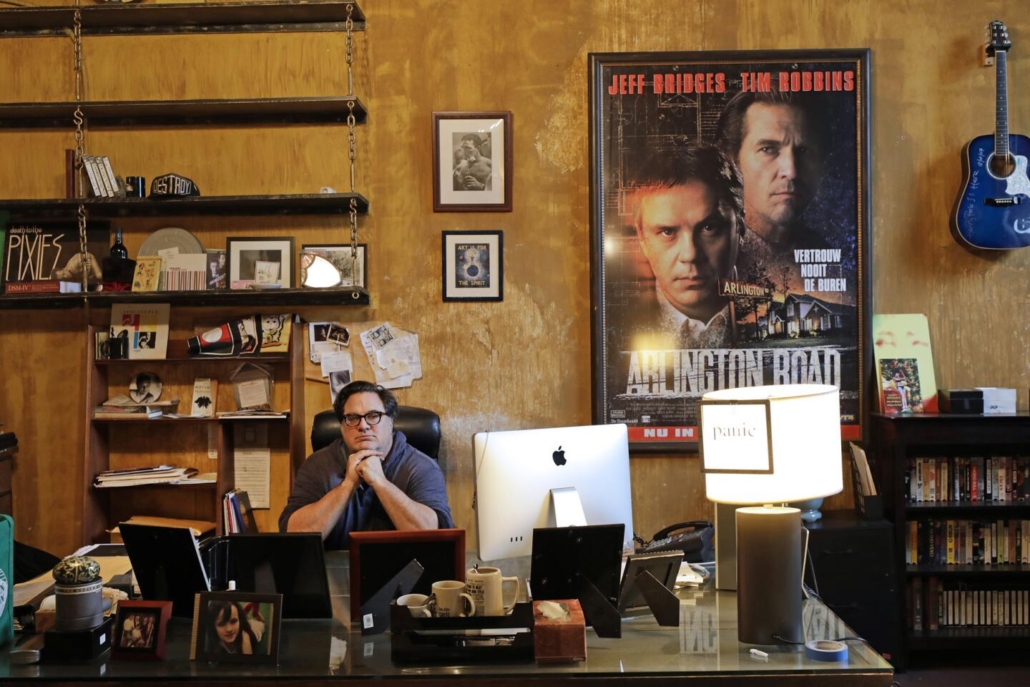A CONVERSATION WITH MARK PELLINGTON (PART TWO)
June 23, 2014
By Adam Barnick
Mark Pellington needs little introduction to film fans. Getting his start working for MTV in its heyday producing interstitial promos led to music videos for such heavyweights as Pearl Jam, Bruce Springsteen, Foo Fighters, Nine Inch Nails and Moby. Beginning his feature film career with the period drama Going All The Way led to atmospheric, frightening thrillers like Arlington Road and The Mothman Prophecies; and most recently the uplifting, earnest Henry Poole is Here and the palpably bleak I Melt With You. On top of that he’s created personal documentaries, commercials, TV pilots; and gone where his creative needs take him.
Mark graciously made time for us to have a candid conversation encompassing his recent film work; bouncing back from loss; his trust in intuition through the making of his abstract, creepy/beautiful musical film LONE, and ultimately the healing and cathartic rewards of the creative process. Some of it may read a bit too ‘inside’, if you have yet to see LONE; but we hope you’ll find this casual interview an incentive to seek it out. Mark and the Icons of Fright staff are both equally excited to see where his muse will lead him next.
Part two continues our in-depth analysis of Mark’s process while creating LONE.
Click here for part one of this interview.
Click here if you haven’t read our First Look/analysis of LONE yet.
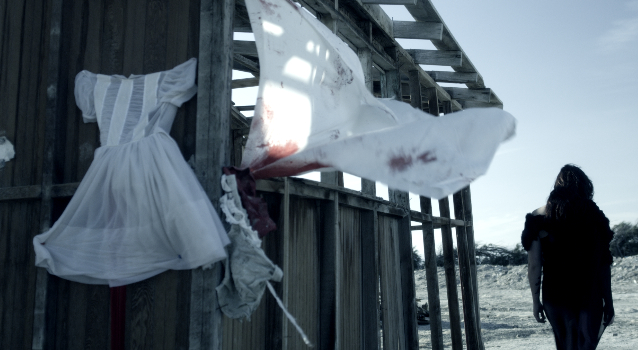
AB: You had a great note on the DVD commentary on The Mothman Prophecies regarding working with actors. How they don’t want to play a result, they want to be guided in a way that will help bring that result through the character’s actions..
MP: Yep!
AB: When I was watching LONE, I was seeing it as an abstract piece- but you don’t really direct an actor as an abstract concept. Or do you in this case? The father figure who appears, the preacher, I interpreted him as both actually..
MP: Yep.
AB: He’s another one with shockingly intimate closeups. I was taken aback when he cries. Working with him, did you break things down that way, or down to simple gestures and ask him to fill in the blanks, did you talk backstory to help him as an actor, to go to places naturally?
MP: I’m so lucky. I did not speak to him about anything! He was this guy (actor Richard Kray) who came in, I loved his face, I’d seen him in a lot of movies. I said to him, “You’re a lot of people, you’ve killed people, you feel this great shame over what you’ve done, yet you hold this great power over her.” Something along those lines is all I said to him. Then it was like “Stand there. OK, kneel.”
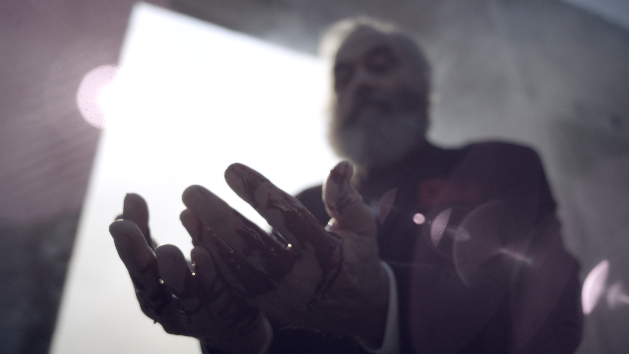
Everything else, he did. Every gesture and pose, he “knew.” In the chair, in the theater, he just felt it. Know what I mean? Great guy. He thought I was like ‘the maestro’ and I didn’t tell him anything! He reminded me of Will Patton on Mothman. Where I didn’t say anything but you’re communicating on this other level.
AB: Feels like the intuition you brought to this was permeating through everybody.
MP: I may have said some things, drawn some things.but with Richard I remembered, he kind of just “was.” And I responded to what he did. “OK, the woman’s on the table; Chelsea, stand here- Richard, stand there, I’m going to play the song, and I just want you…” they just did it! Know what I mean?
Richard and I were just on that wavelength, where he felt what he felt. And we were like “Go into the ocean!” And when he came up I remember screaming “Come to me! Come to me! You fucking killed her! Come to me, you killed her!” and he came up and there’s a shot where he rushes right up and the look on his face is…
Maybe sometimes I would have an image, or ask something like “Who did you kill?” Who is she? Who is she?” Probably something came out of me that I was channeling, that I wasn’t really sure of. That’s the downside of flying by the seat of your pants. Everyone’s looking at you and you’re like fuck, I don’t know. Sometimes you have to ask “Is this feeling right?’ The tall guy is chasing these girls around and you’re like “his mask looks so cheesy, it doesn’t fit right. I’m watching a tall 6 foot 10″ extra chase the girls around, I’m not watching some specter of some monster chase youth.” You know? The illusion is broken. There’s a few shots in it where you can manipulate the image enough, and put it in context, you can get away with a few shots; but what he is, is not working- it was too on the nose that he’s Death.
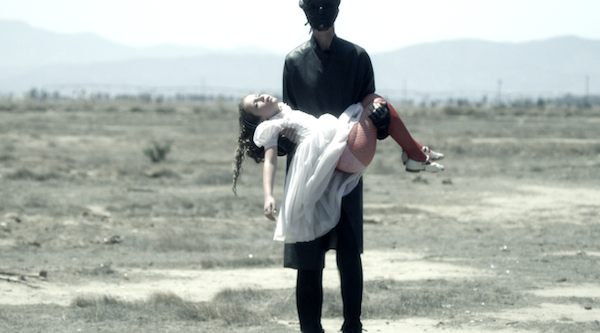
When I realized later that it was the father; he was Death, the provider, the teacher, the healer, he’s leading the girls to the sheets and leading them away, but protecting one of them, actually maybe killing the other one. I had some images where he was like putting his hands on the neck of the girls..I was like, no, no. I don’t want that. I’m a Dad. I was like “fuck no.”
AB: Working with Chelsea, what’s your process there? Because you’ve got to bring her to the place she’s at when she performs these songs, but also work with her as an actress for the nonperformance moments.
MP: It was very improvisational and very intuitive. Some songs were a skin that she felt it was easier to slip into. Like “House of Metal”, the dark lights and spooky, hidden, single-source light, she was able to connect. I was one foot away from her with the camera, I think we played the song three times and she got into a very intimate, trusting place. I think in some more of the natural environments, like the woods where it was brighter and she was more aware of the camera.. like any performer, it was just getting her to trust the space she was in, emotionally, there was nothing that she could do wrong. In any way shape or form. If she was feeling the authentic feelings, that she felt when she wrote the song, or was transported to that place.. that’s all I wanted her to feel. You’d have her going to her look in an elegant, trippy forest setting, to black eye contacts wearing all black…so each (sequence), she kind of takes on a different persona. Each wardrobe choice, styling, hair and makeup, and environment were really kind of atmospheres. And she was ‘herself’ in all of them.
I wasn’t directing her, as much as pushing her to let out, or push in, whatever was there. Some people are very natural performers in front of the camera. She wasn’t a natural performer, and I wanted her to be who she was, you know? And therefore kind of establish her performance persona. Like a Lorde, Lana Del Rey, Roy Orbison..you don’t have to move around to be a performer. You have to just have something. And for me, I wanted to keep looking at her through the lens. I find her beautiful, and fascinating and incredible to photograph. And I love her whole team, of her hair and costumes..her people are part of her persona and they were very collaborative.
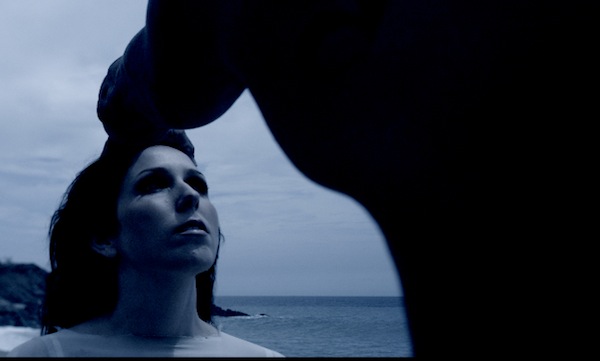
AB: Getting back to what you said about Richard’s character potentially hurting the girls; I don’t know if I necessarily felt there was a murder of one, I definitely felt a smothering control from the father figure, and that was something that Chelsea’s character was coming to terms with.
MP: They both killed…I think for me, the father definitely was responsible for the death of the woman.
AB: The mother, yes.
MP: He’s trying to reverse it- that’s why we have (the shot where) she’s naked and dead, and he lets the sheet go back over her. And Chelsea looks at him and he’s looking away, yet he’s looking at the masked figure…there’s all sorts of layers there. For me, my wife as a child, my daughter, my mother, my mother’s death and my wife’s death- my daughter’s world and my wife as a child- they’re all in there. And then the girls- it was interesting, Chelsea said she wanted the twins, I think.. I immediately went to like representations of aspects of your ego and id, and superego, two sides of one, that’s why one’s getting carried..
AB: I always felt that, that there was one girl.
MP: At the end, they go to Chelsea and she whispers something to them, and to me that was their release. The mother closes her eyes and the little kids are running by the ocean. That’s the only time you see them without the masks is by the water. And bowing at the horse- kneeling at the power of the horse. The horse is a huge icon (for me), my father was a horse-my father’s nickname was the Iron Horse, playing football, horses were really big for Chelsea, that became a big motif. There’s like a weird Western aspect out in the desert, and her music has that kind of twang… The beach was like a white stage; the water I loved, water’s a big part of my life and my memory for me. In my upbringing.
AB: Chelsea has a line of dialogue in there about that too, about equating water with memory.
MP: Yeah! That’s why I related to her music. Nature, and her song “The Waves will Come”, surrounded by burned-out woods, and the beach and the desert and the sky and all these natural places that felt great. The two structures (shown in the story of LONE) are really the kind of broken homes. Decayed institutions.. They were both homes. Her music has such texture. Such spooky, gothic, heavy tones.
AB: It’s an incredibly lush audio atmosphere. Some of the soundscapes in between the songs reminded me of Claude Letessier’s sound design for Mothman, I had to check- I was wondering if he’d had something to do with this project. But all of that is Chelsea and Ben(Chisholm), right?
MP: Yes. And I would work with them again, doing it. We’re already talking about that, saying let’s do something like a movie. They’re really talented, and they really want to do more score stuff.
She’s not bowing to any sort of pop music structural rules..no verse/chorus shit going on here. That’s what I loved about it. When I was putting it together, I was pulling pieces from some of her earlier albums..
AB: You mean the soundscape/atmospheric effects in between her album’s songs? Bits of sound design?
MP: Yeah, and they said “We want to do some newer stuff for you.” So we’re editing, and Ben sent me all the stems, all the pieces; it makes editing so easy. I can get in and out of the songs and have long buildups in and out of it, that will all feel right.
AB: Yeah, totally natural. Never felt like breaks in between songs. Did you always play her music on set? To set the tone even when not singing?
MP: Always.
AB: Certain times in the film, we see Chelsea singing the song, but I loved by the end where “Lone” is played, it wasn’t synced to a performance at all. It was just simply the soundtrack to her performance as the character, and the image.
MP: She did the song “Sick”, where she’s singing in the woods, she also did that at the beach.. I think on the sand, there’s a take of that where she performed the whole thing. Really a kind of beautiful, painful dance. That one, we knew – I said “let’s just have her sing it here,” but I wasn’t sure where that would go. I knew the “Waves” performance was the middle of the film, and I knew that “Feral Love” was the beginning, I knew “Lone” would be at the end but I knew she wasn’t gonna sing “Lone.” Maybe I asked her to and she said no, she was so tired at the end of the day. Just emotionally wrecked and devastated. I knew that we could edit the thing and not have any lip sync in it at all. But sometimes that narration or storytelling is often really the main emotional connection.. I guess “House of Metal” is the most traditional ‘music video’ (portion).
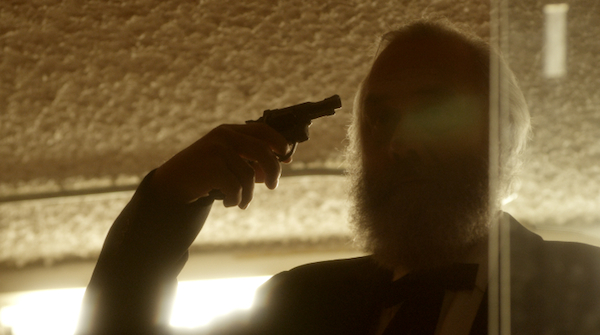
AB: Was this all shot at once, like a traditional show? Or did you go back and keep shooting as you cut if you felt you needed more? Did you have like one six-day week, or two six-day weeks..
MP: Three days.
AB: Three days for everything? Oh my god. (laughs) Did you shoot more later?
MP: Nope. One day at the desert, the morning at the house, moved to an open space, and then ended at the (abandoned house in) “Lone”, that was one day. Then a day, a morning at the beach, and then moved to the woods; and then an interior stage, where we shot “House of Metal.” Yep, three days. And some home movies edited in, some of that stock footage.
AB: Did you always intend to have that horrifying flood/tsunami footage, in the ‘waves’ sequence?
MP: Yeah. When she first talked about doing a video for that song, those were some of the images she was inspired by.
AB: All the disaster footage, it really builds..It made me, personally, ridiculously anxious. (laughs)
MP: Yeah! The song makes you really anxious. It’s funny; this is where the generational thing comes in. I’m 52, I still have a visceral reaction to the thought of a nuclear war. For me, that was a palpable threat growing up. So that footage (of atomic tests) still disturbs me. I don’t know if that would disturb a 14 year old. Perhaps terrorism has supplanted the post-Cold War “The Russians are gonna nuke us” as the threat.
AB: I’d agree with that. But it just kind of builds, atrocity upon atrocity. The shots of the floods were such long “takes”, if you will, that I was like “oh my god, I’m really seeing this.” It felt forbidden, in a way.
MP: Yeah.
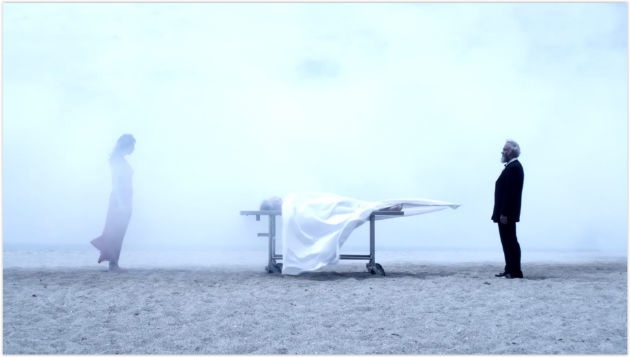
AB: Working with your cinematographer Matt Roe, did you take the same loose, improvisational approach to the shoot? You’re not defining the meanings of everything so far ahead of time, so you can’t be telling your cinematographer two weeks before the shoot, something like “This scene’s gonna be about isolation, so we should probably shoot it on a 100mm lens..” How did you keep his process as intuitive?
MP: Well Matt started as my intern on Henry Poole, and immediately gravitated towards the camera department. He’d gone to AFI. He’s the one who got me into shooting on the 5D. We’d do these videos and he would shoot second unit, inserts, and macro shots. And on I Melt With You, he did all our second unit. Beautiful stuff. Then he started shooting more for other people and then recently within the last year, he shot our Cage the Elephant video, he shot the Jason Mraz video we did, shooting for me as a real shooter. And he knows me so well.
We always talk about “What’s the look, what’s in the wheelhouse?” Sometimes we discipline ourselves and say we only want to use two lenses, old lenses, old uncoated lenses, new ones are too sharp..do we need a zoom, swing and tilt, how do we want to fuck it up, sometimes I like the zoom to find different focal lengths, if I need to get six shots and I don’t have time to take the camera on and off and change lenses..
Ideally you just want to carry all the shit all the time, all the zooms, all the primes but you can’t. Matt pulled a lot of favors on this shoot. Matt knows me really well, and I trust him and he’s really talented.
We always have two cameras, so I operate, I was probably shooting – he’d bring the light in, he would be off shooting one of the kids, sometimes we shoot independently. He’s seeing what I’m doing, and I’m responding to what he’s doing..You’re kind of like mixing live, you know what I mean? Like if you were a DJ mixing. It’s a good team.
AB: I tried to analyze LONE in my own way; we always tend to impose a narrative on pieces like this, looking at things symbolically. I also tried to frame it in the context of other work you’ve done. Have you had enough time away from this project that you’ll now look back and see thematic similarities, editing similarities, etc.? I thought of this as definitely a companion piece to stuff you’ve done, but I’m wondering if you even go there in terms of analysis.
MP: You know, last May they had an exhibit in New York called Spectacle, at the Museum of the Moving Image in Queens. There were a couple of my videos in there, Pearl Jam, U2 3D… They asked me to come, I showed three 15-minute chunks of work. Pretty much from my twenties, thirties and my forties. I said it was “Speed, memory, and trauma.” Speed was in my twenties’ (output), memory was when my Dad died and I was interested in mortality in my thirties, and then trauma and healing in my forties. And it was really interesting.. I’d never really sat and watched it all. Certain things and motifs came up..and a friend came up and said “You’re working through the same stuff over all these years, it’s the same stuff.” Same stuff keeps coming back.
I think if you lay it all out, and then look at LONE, there’s certainly antecedents and images, approaches and techniques and even moments that I’ve certainly explored before. Without a doubt, I think the relationships of the people were new, and the fact that there wasn’t really dialogue in it, opened it up to another thing. Certainly in music videos, I see the stuff for sure. Definitely.
AB: If you don’t mind I’ll share some of my thoughts on it.
MP: Please!
AB: I saw a great quote on your site, about catharsis: “The work is a process of bringing to the surface repressed emotions, complexities and feelings in an effort to identify them and release them.”
That nailed it for me. I consider that your process as an artist, but I personally related it to the journey of Chelsea’s character in the movie as well. To me, she is digging through all of that. I linked this film to your work in “Father’s Daze” and “Of time and Memory.”
MP: Yep!
AB: You’ve got characters that are confronting and clarifying the past and trying to make sense of it, and connect to it fully, whether they were present for it or not.
MP: That’s probably the theme of everything, to be honest with you. That certainly was probably the relationship to her music that I felt, and that … that’s funny. You’re exactly right with her, and me, but neither of us ever stated explicitly “This is what we are creating.” In any way, shape, or form.
I think that’s why at the end, when we finished mixing.. She’s very quiet, Chelsea. Gentle. We finished mixing, and I said to her “Thank you. That was really healing, to do. To create. And thank you for the music and thank you for the chance. Thank you for letting me explore all this stuff.” She said “It was incredibly healing for me, too.”
So that, her music, she gave me the freedom to create the images inspired by the music, and that’s why I love music and the freedom of it. It opens me up, I close my eyes and start to see stuff.
-Adam Barnick

LONE is available via custom USB drives, at the first three links below. It will be available via traditional digital channels soon.
Icons of Fright Archive
2024
2015
2014
- Rob G’s Best Horror Soundtrack Releases of 2014!
- ROB G.’S TOP 10 HORROR FILMS OF 2014!
- 6 UNDERRATED MOVIES YOU SHOULD WATCH THIS HALLOWEEN!
- ICONS PIRATE COMMENTARY: THE WARRIORS WITH SEAN CLARK & ROB G!
- THE VAULT: SCARY MOVIE (1991)
- REVIEW: DEXTER DOWN UNDER
- Event Report! The Big Picture: Hitchcock! Live!
- EVENT REPORT: TEXAS CHAINSAW SCREENING WITH WILLIAM FRIEDKIN & TOBE HOOPER!
- A CONVERSATION WITH MARK PELLINGTON (PART TWO)
- A CONVERSATION WITH MARK PELLINGTON (PART ONE)
- FIRST LOOK: MARK PELLINGTON’S “LONE”
- Stuart Gordon’s TASTE Is Now Open! ICONS’ Brief Thoughts!
- 10 Years Of ICONS OF FRIGHT! A Note From The Editors…
- 10 Horror Icons That Deserve Action Figures
- THE SHORT FILMS OF STEVE DANIELS!
2013
- ICONS OF FRIGHT PRESENTS ROB G.’S TOP 5 SDTKS OF 2013!
- ICONS OF FRIGHT PRESENTS ROB G.’S TOP 10 HORROR OF 2013!
- FAN COMMENTARY: ICONS ROB G & AJ BOWEN ON SILENT NIGHT DEADLY NIGHT 2!
- Happy 30th To Michael Jackson’s THRILLER!
- HALLOWEEN 5… THE MOST MISLEADING TEASER TO THE MOST DISAPPOINTING MICHAEL MYERS FILM
2012
- ROB G.’S TOP HORROR PICKS OF 2012!
- FIRST LOOK: MANIAC (2012)
- 7 Horror Movies To Put The FUN In Your HALLOWEEN!
- FRIGHT EXCLUSIVE INTERVIEW: RICHARD BATES JR. Director of EXCISION!
- NEW ICONS INTERVIEW- PAUL SOLET (2012)
- FRIGHT EXCLUSIVE INTERVIEW: Anna Biller (Writer/Director/Star of VIVA)!
2011
- Icons Of Fright presents Robg’s TOP 10 Horror Movies of 2011!
- FRIGHT EXCLUSIVE PIRATE COMMENTARY – HALLOWEEN 6: THE CURSE OF MICHAEL MYERS with writer Daniel Farrands
- FRIGHT INTERVIEW – Frank Henenlotter, Writer/Director of BASKET CASE
- TRICK ‘R TREAT Writer/Director Michael Dougherty’s Halloween Movie Picks!
- ICONS INTERVIEW: Nick Principe, Chromeskull of LAID TO REST
2010
- Paul Solet in “Predator Mode” on the set of GRACE
- Adam Green & Paul Solet Talk In Fahkin Boston Accents (With subtitles kid!)
2009
- ICONS INTERVIEW: Writer / Director Glenn McQuaid
- Hyaena Presents: How Much Is That Barker In the Window?
- ICONS INTERVIEW: Paul Solet, Writer Director of GRACE
- ICONS INTERVIEW: Actress Jordan Ladd From GRACE
- ICONS INTERVIEW: GRACE Producer Adam Green
- THE COLLECTOR: ICONS INTERVIEW with Marcus Dunstan & Patrick Melton
- ICONS INTERVIEW: Dave Parker, Director of THE HILLS RUN RED
- ORPHAN: ICONS INTERVIEWS!
- UPDATE: Are The Right Subtitles On LET THE RIGHT ONE IN Yet?!
- ICONS INTERVIEW: Writer Director Rob Zombie on HALLOWEEN 2
- ICONS INTERVIEW: THE BURROWERS Director JT Petty
- Hyaena Presents: Mark Ryden Is Not a God
- ICONS INTERVIEW: Actress / Producer Bobbi Sue Luther
- Rob Zombie’s HALLOWEEN 2 SET REPORT PART 4: ACTRESS SCOUT TAYLOR-COMPTON!
- Rob Zombie’s HALLOWEEN 2 SET REPORT PART 3: PRODUCER ANDY GOULD!
- Rob Zombie’s HALLOWEEN 2 SET REPORT PART 2: PRODUCER MALEK AKKAD!
- Rob Zombie’s HALLOWEEN 2 SET REPORT PART 1: FX ARTIST WAYNE TOTH!
- Hyaena Presents: Welcome to the Art Massacre
- HYAENA GALLERY INTERVIEW: An Icons of Fright Video
- DARK DELICACIES INTERVIEW: An Icons of Fright Video
- Let The Wrong Subtitles In To LET THE RIGHT ONE IN?!
- ICONS INTERVIEW: Actor / Filmmaker William Butler
- ICONS INTERVIEW: Director Jeff Burr
- ICONS INTERVIEW: Actor Oliver Robins From POLTERGEIST
- Adam (Evil) Barnick’s Top Ten Scariest Television Moments
- ICONS INTERVIEW: Derek Mears, Jason Voorhees From FRIDAY THE 13TH 2009
- REPO Madness: A Night At The GENETIC OPERA
- FIRST LOOK: HIS NAME WAS JASON: 30 YEARS OF FRIDAY THE 13TH
- ICONS INTERVIEW: Composer Joseph Bishara
2008
- TERRIFYING TOYS: An Icons Of Fright Video
- From The Set of GRACE: Adam Green Message To ICONS OF FRIGHT Readers
- ICONS INTERVIEW: Susan Montford, Director of WHILE SHE WAS OUT
- ICONS OF FRIGHT BEST & WORST HORROR MOVIES OF 2008
- FIRST LOOK: MAIDENHEAD
- THE VAULT OF THE FORGOTTEN AND THE OBSCURE: ISSUE 19
- THE VAULT OF THE FORGOTTEN AND THE OBSCURE: ISSUE 18
- ICONS INTERVIEW: Horror Icon Bruce Campbell!
- ICONS INTERVIEW: THE GHOULIGANS!
- ICONS INTERVIEW: Tomas Alfredson, Director of LET THE RIGHT ONE IN
- ICONS INTERVIEW: Zach Passero, Director of WICKED LAKE
- ICONS INTERVIEW: Writer / Director Mick Garris
- ICONS EXCLUSIVE: Tom Holland’s Director Commentary For CHILD’S PLAY! FREE DOWNLOAD!
- FIRST LOOK: LET THE RIGHT ONE IN
- FIRST LOOK: FANTASTIC FLESH – The Art of Make-Up EFX
- ICONS INTERVIEW: Jeremy Kasten, Director of WIZARD OF GORE
- ICONS INTERVIEW: Actress Erika Smith
- FIRST LOOK: RETURN TO SLEEPAWAY CAMP
- ICONS INTERVIEW: Writer / Actor Joshua Nelson, Interview 2
- ICONS INTERVIEW: Tuesday Knight From A NIGHTMARE ON ELM STREET 4: THE DREAM MASTER
- AN UNTITLED LANCE HENRIKSEN ROMANTIC COMEDY! From The Creator Of WE NEED GIRLFRIENDS!
- ICONS INTERVIEW: Actor Brian O’Halloran From CLERKS, BRUTAL MASSACRE
- ICONS INTERVIEW: Writer / Director / Actor Larry Fessenden
- FIRST LOOK: [REC]
- ICONS INTERVIEW: BRUTAL MASSACRE Writer / Director Stevan Mena
- FRIGHT EXCLUSIVE: The PSYCHO Reunion Panel, FANGORIA Weekend Of Horrors 2008
- ICONS INTERVIEW: John Russo, Writer of NIGHT OF THE LIVING DEAD
- FIRST LOOK: THE MIDNIGHT MEAT TRAIN
- ICONS INTERVIEW: Writer / Director Eric Red
- FRIGHT EXCLUSIVE: The FRIGHT NIGHT Reunion Panel At FEAR FEST 2
- ICONS INTERVIEW: Troma Entertainment President Lloyd Kaufman
- ICONS INTERVIEW: Actress Gina Philips From JEEPERS CREEPERS
- ICONS INTERVIEW: MR. MONSTER Creator Michael T. Gilbert
- ICONS INTERVIEW: Neil Marshall, Writer / Director of THE DESCENT
- ICONS INTERVIEW: Actor / Director Keith Gordon
- PROM NIGHT: Revisited
- ICONS INTERVIEW: Gunnar Hansen, Leatherface From THE TEXAS CHAIN SAW MASSACRE
- GRINDHOUSE AFICIONADO: ISSUE 6
- ICONS INTERVIEW: Dick Durock From SWAMP THING
- ICONS INTERVIEW: Actors Zachary Levi and Joel David Moore From SPIRAL
- ICONS INTERVIEW: Actor AJ Bowen From THE SIGNAL
- FIRST LOOK: CLOVERFIELD
- ICONS INTERVIEW: Charlie Benante, The Drummer of ANTHRAX
- ICONS INTERVIEW: Anessa Ramsey & Justin Welborn of THE SIGNAL
2007
- ICONS INTERVIEW: John Kassir, The Voice Of THE CRYPTKEEPER!
- ICONS OF FRIGHT TOP HORROR PICKS FOR 2007
- ICONS INTERVIEW: FX Artist & Creature Performer Tom Woodruff Jr
- ICONS INTERVIEW: The Producers Of THE SHARK IS STILL WORKING
- ICONS INTERVIEW: Cinematographer Will Barrett
- ICONS INTERVIEW: Filmmaker Jane Rose
- ICONS INTERVIEW: DRIFTWOOD Director Tim Sullivan, Interview 2
- ICONS INTERVIEW: Actress Cerina Vincent From CABIN FEVER
- ICONS INTERVIEW: Actress & Scream Queen Tiffany Shepis
- ICONS INTERVIEW: Writer / Director Rolfe Kanefsky, Interview 2
- ICON INTERVIEW: Jim Mickle, Director of MULBERRY STREET
- THE VAULT OF THE FORGOTTEN AND THE OBSCURE: ISSUE 17
- ICONS INTERVIEW: Horror Host ELVIRA, Mistress Of The Dark!
- ICONS INTERVIEW: Jeffrey Combs From RE-ANIMATOR
- THE TV MOVIE TERROR COLLECTION: CRAWLSPACE and THE DEVIL’S DAUGHTER
- ICONS INTERVIEW: WRONG TURN 2 Director Joe Lynch
- ICONS INTERVIEW: Actress Erica Leerhsen From WRONG TURN 2, TEXAS CHAINSAW
- ICONS INTERVIEW: Zelda Rubinstein From POLTERGEIST
- ICONS INTERVIEW: Paul Ehlers, “Madman Marz” From MADMAN!
- ICONS INTERVIEW: Actor Joel David Moore From HATCHET
- ICONS INTERVIEW: Actress Tamara Feldman From HATCHET
- ICONS INTERVIEW: Actress Mercedes McNab From HATCHET
- ICONS INTERVIEW: Deon Richmond From HATCHET, SCREAM 3
- ICONS INTERVIEW: Writer Director Rob Zombie on HALLOWEEN!
- FIRST LOOK: WRONG TURN 2: DEAD END
- ICONS INTERVIEW: Bill Johnson, Leatherface From TEXAS CHAINSAW MASSACRE 2
- FIRST LOOK: SPACEDISCO ONE
- ICONS INTERVIEW: Actress Vigdis Anholt From LITTLE ERIN MERRYWEATHER
- FIRST LOOK: 100 TEARS
- FIRST LOOK: BRUTAL MASSACRE, A COMEDY
- ICONS INTERVIEW: Italian Actress Coralina Cataldi-Tassoni
- ICONS INTERVIEW: David J Stieve, Writer Of BEHIND THE MASK
- ICONS INTERVIEW: Mike Mendez, Director of THE GRAVEDANCERS
- GRINDHOUSE AFICIONADO: ISSUE 5
- FIRST LOOK: POSTAL … Uwe Boll’s CITIZEN KANE
- FIRST LOOK: THE SIGNAL
- ICONS INTERVIEW: Eric Nicholas, Writer Director of ALONE WITH HER
- FIRST LOOK: HOSTEL PART II
- FIRST LOOK: BLACK SHEEP
- ICONS INTERVIEW: Actress Natassia Malthe
- THE VAULT OF THE FORGOTTEN AND THE OBSCURE: ISSUE 16
- HELLGATE: A Crap Movie Discovery From Mike C.
- ICONS INTERVIEW: Writer / Director Dave Parker
- FIRST LOOK: THE SHARK IS STILL WORKING
- ICONS INTERVIEW: Writer / Director Rolfe Kanefsky
- ICONS INTERVIEW: Filmmaker Christopher P. Garetano Interview 2!
- ICONS INTERVIEW: Arrow In The Head’s John Fallon
- FIRST LOOK: THE TRIPPER
- FIRST LOOK: SEVERANCE
- ICONS INTERVIEW: Writer Joe Harris, THE TRIPPER!
- ICONS INTERVIEW: Producer / Director Tony Krantz
- ICONS INTERVIEW: Gordy Haab, Composer Of BEHIND THE MASK
- ICONS INTERVIEW: Actor Nathan Baesel From BEHIND THE MASK: THE RISE OF LESLIE VERNON
- ICONS INTERVIEW: Scott Glosserman, Director Of BEHIND THE MASK
- ICONS INTERVIEW: Filmmaker James Felix McKenney
- FIRST LOOK: DRIFTWOOD
- FIRST LOOK: PERFUME – THE STORY OF A MURDERER
- FIRST LOOK: BARRICADE
- ICONS INTERVIEW: Director Bryan Norton
- ICONS INTERVIEW: Actress Christie Sanford From SATAN’S PLAYGROUND
- THE VAULT OF THE FORGOTTEN AND THE OBSCURE: ISSUE 15
2006
- ICONS OF FRIGHT TOP HORROR PICKS FOR 2006
- ICONS INTERVIEW: Ryan Ward, Ash From EVIL DEAD: THE MUSICAL
- ICONS INTERVIEW: Kevin Kangas, Writer Director of FEAR OF CLOWNS 2
- THE VAULT OF THE FORGOTTEN AND THE OBSCURE: ISSUE 14
- FIRST LOOK: EVIL DEAD: THE MUSICAL
- GRINDHOUSE AFICIONADO: ISSUE 4
- ICONS INTERVIEW: Ken Sagoes From A NIGHTMARE ON ELM STREET 3
- ICONS INTERVIEW: Judah Friedlander!
- ICONS INTERVIEW: SCREAM’s David Arquette!
- ICONS INTERVIEW: Ryan Schifrin, Writer Director of ABOMINABLE
- ICONS INTERVIEW: John Shiban, Director of REST STOP
- ICON INTERVIEW: JT Petty, Director S&MAN
- THE VAULT OF THE FORGOTTEN AND THE OBSCURE: ISSUE 13
- FIRST LOOK: FEAST
- FIRST LOOK: THE WOODS
- ICONS INTERVIEW: Nick Palumbo, Writer Director of MURDER SET PIECES
- ICONS INTERVIEW: Actress Raine Brown
- ICONS INTERVIEW: Writer Director Filmmaker Gary Sherman
- FIRST LOOK: 39 – A FILM BY CARROLL MCKANE
- GRINDHOUSE AFICIONADO: ISSUE 3
- ICONS INTERVIEW: Actress Lin Shaye From 2001 MANIACS!
- ICONS INTERVIEW: Actress Christa Campbell From 2001 MANIACS!
- ICONS INTERVIEW: Actor David Morwick From LITTLE ERIN MERRYWEATHER
- THE VAULT OF THE FORGOTTEN AND THE OBSCURE: ISSUE 12
- ICONS INTERVIEW: FX Artist Greg Nicotero of KNB!
- FIRST LOOK: THE DESCENT
- FIRST LOOK: BEHIND THE MASK – THE RISE OF LESLIE VERNON
- ICONS INTERVIEW: Mark Pavia, Writer Director of NIGHT FLIER
- GRINDHOUSE AFICIONADO: ISSUE 2
- ICONS INTERVIEW: Comic Writer Steve Niles, Creator of 30 DAYS OF NIGHT
- ICONS INTERVIEW: Adam Green, Writer Director of HATCHET!
- ICONS INTERVIEW: Actor / Filmmaker Joe Zaso
- THE VAULT OF THE FORGOTTEN AND THE OBSCURE: ISSUE 11
- GRINDHOUSE AFICIONADO: WHAT THE HELL? 6/6/06 EDITION!
- ICONS INTERVIEW: James Wan, Director of SAW!
- ICONS INTERVIEW: Actor Liev Schreiber on THE OMEN!
- ICONS INTERVIEW: Actress Julia Stiles on THE OMEN!
- ICONS INTERVIEW: Actress Mia Farrow on THE OMEN!
- ICONS INTERVIEW: John Moore, Director of THE OMEN
- My Date With Death Ship: A Horror Geek Love Story by Mike C.
- FIRST LOOK: HATCHET
- FIRST LOOK: LITTLE ERIN MERRYWEATHER
- FIRST LOOK: Takashi Miike’s IMPRINT
- GRINDHOUSE AFICIONADO: ISSUE 1
- ICONS INTERVIEW: Actress Wendy Kremer From 2001 MANIACS
- ICONS INTERVIEW: Actor Mushmond Lee From 2001 MANIACS
- THE VAULT OF THE FORGOTTEN AND THE OBSCURE: ISSUE 10
- ICONS INTERVIEW: Filmmaker David “Slave” Stagnari
- ICONS INTERVIEW: Filmmaker Will Rot
- ICONS INTERVIEW: Tibor Takas, Director of THE GATE
- ICONS INTERVIEW: Actor Danny Lopes
- THE VAULT OF THE FORGOTTEN AND THE OBSCURE: ISSUE 9
- ICONS INTERVIEW: Writer / Director Oz Perkins
- ICONS INTERVIEW: Filmmaker Steve Daniels
- FIRST LOOK: SLITHER
- ICONS INTERVIEW: Filmmaker Composer Jake Hamilton
- FIRST LOOK: THE HILLS HAVE EYES (2006)
- FIRST LOOK: NIGHTWATCH
- THE VAULT OF THE FORGOTTEN AND THE OBSCURE: ISSUE 8
- ICONS INTERVIEW: Director Uwe Boll
- ICONS INTERVIEW: Filmmaker Steven Shea
- THE VAULT OF THE FORGOTTEN AND THE OBSCURE: ISSUE 7
2005
- HALLOWEEN… What Now?!
- FRIDAY THE 13TH: THE REMAKE?!
- ICONS INTERVIEW: Writer / Director Paul Solet
- THE VAULT OF THE FORGOTTEN AND THE OBSCURE: ISSUE 6
- ICONS INTERVIEW: Don Shanks, Michael Myers In HALLOWEEN 5
- ICONS INTERVIEW: Paul Kratka From FRIDAY THE 13TH PART 3
- ICONS INTERVIEW: WE ALL FALL DOWN Writer / Director Jake Kennedy
- FIRST LOOK: SATAN’S PLAYGROUND
- ICONS INTERVIEW: SIN-JIN SMYTH Writer / Director Ethan Dettenmaier
- ICONS INTERVIEW: THE RADIO MECHANICS Writer / Director Jonathan Johnson
- MORGAN STEWART’S RETURN FROM THE GRAVE!
- THE VAULT OF THE FORGOTTEN AND THE OBSCURE: ISSUE 5
- ICONS INTERVIEW: Interview 2 with Writer / Director Stevan Mena
- ICONS INTERVIEW: Interview 2 with Writer / Director Dante Tomaselli
- HALLOWEEN… Sequel or Remake?
- ICONS INTERVIEW: HORROR BUSINESS Director Christopher P. Garetano
- ICONS INTERVIEW: Writer / Director Adam Barnick
- ICONS INTERVIEW: Filmmaker / Horror Collector John Torrani
- ICONS INTERVIEW: Writer / Actor Joshua Nelson
- GEORGE A. ROMERO… MORE THAN JUST ZOMBIES!
- THE VAULT OF THE FORGOTTEN AND THE OBSCURE: ISSUE 4
- ICONS INTERVIEW: HALLOWEEN 6 Screenwriter Daniel Farrands
- ICONS INTERVIEW: Patricia Tallman From NIGHT OF THE LIVING DEAD 1990
- THE VAULT OF THE FORGOTTEN AND THE OBSCURE: ISSUE 3
- ICONS INTERVIEW: BLACK CHRISTMAS Director Bob Clark
- THE VAULT OF THE FORGOTTEN AND THE OBSCURE: ISSUE 2
- ICONS INTERVIEW: Edwin Neal From THE TEXAS CHAIN SAW MASSACRE
- ICONS INTERVIEW: Ben Chapman, The Gillman From CREATURE FROM THE BLACK LAGOON
- THE VAULT OF THE FORGOTTEN AND THE OBSCURE: ISSUE 1
- ICONS INTERVIEW: Brandon Johnson From MALEVOLENCE
- ICONS INTERVIEW: Samantha Dark From MALEVOLENCE
- ICONS INTERVIEW: Keith Chambers From MALEVOLENCE
- FIRST LOOK: CREEP
- ICONS INTERVIEW: Judith O’ Dea From NIGHT OF THE LIVING DEAD
- FIRST LOOK: HIGH TENSION
- Icons Of Fright Meets Shaun Of The Dead!
- ICONS INTERVIEW: Paul Swearingen
- ICONS INTERVIEW: Lance Warlock From HALLOWEEN II
2004
- ICONS INTERVIEW: Diana Barrows From FRIDAY THE 13TH 7
- ICONS INTERVIEW: Brad Loree, Michael Myers in HALLOWEEN: RESURRECTION
- ICONS INTERVIEW: Burton C Bell of FEAR FACTORY
- ICONS INTERVIEW: PJ Soles From HALLOWEEN
- ICONS INTERVIEW: Ellie Cornell From HALLOWEEN 4
- ICONS INTERVIEW: Stevan Mena, Writer & Director of MALEVOLENCE
- ICONS INTERVIEW: Felissa Rose, Angela From SLEEPAWAY CAMP
- ICONS INTERVIEW: Ladies Of The EVIL DEAD
- ICONS INTERVIEW: Lar Park Lincoln From FRIDAY THE 13TH 7
- ICONS INTERVIEW: Ron Millkie From FRIDAY THE 13TH
- ICONS INTERVIEW: Warrington Gillette, Jason in FRIDAY THE 13TH PART 2
- ICONS INTERVIEW: Betsy Palmer From FRIDAY THE 13TH
- ICONS INTERVIEW: Larry Zerner From FRIDAY THE 13TH PART 3
- ICONS INTERVIEW: SLEEPAWAY CAMP Webmaster Jeff Hayes
- ICONS INTERVIEW: Tony Timpone from FANGORIA Magazine
- ICONS INTERVIEW: Actor Stu Charno from FRIDAY THE 13TH PART 2
- ICONS INTERVIEW: Writer / Director Dante Tomaselli
- ICONS INTERVIEW: Producer Anthony Masi

